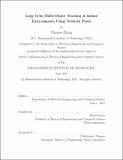| dc.contributor.advisor | Dina Katabi. | en_US |
| dc.contributor.author | Zhang, Thomas, S.M. (Thomas R.). Massachusetts Institute of Technology | en_US |
| dc.contributor.other | Massachusetts Institute of Technology. Department of Electrical Engineering and Computer Science. | en_US |
| dc.date.accessioned | 2018-02-08T15:58:40Z | |
| dc.date.available | 2018-02-08T15:58:40Z | |
| dc.date.copyright | 2017 | en_US |
| dc.date.issued | 2017 | en_US |
| dc.identifier.uri | http://hdl.handle.net/1721.1/113461 | |
| dc.description | Thesis: M. Eng., Massachusetts Institute of Technology, Department of Electrical Engineering and Computer Science, 2017. | en_US |
| dc.description | This electronic version was submitted by the student author. The certified thesis is available in the Institute Archives and Special Collections. | en_US |
| dc.description | Cataloged from student-submitted PDF version of thesis. | en_US |
| dc.description | Includes bibliographical references (pages 47-48). | en_US |
| dc.description.abstract | This thesis presents a system for long-term tracking of multiple people in indoor environments using a min cost flow algorithm to optimize the association of short-term tracklets. This system is built on top of an existing RF-based indoor localization system called WiTrack, which is able to track a number of people without requiring them to hold or wear any special devices. However, WiTrack relies primarily on being able to detect motion from a person to track him, and has its effectiveness limited by other factors such as obstructions and multipath effects. Consequently, WiTrack's strength lies in tracking over shorter time intervals. The system presented in this thesis utilizes these short-term tracklets produced by the WiTrack system and performs optimizations to try and account for missed detections either from lack of motion or from occlusions. This system is designed to utilize information about the indoor environment in which WiTrack is deployed in to make more informed decisions during the tracklet association process. To this end, an accompanying iOS application is built to aid in mapping the room layout during a deployment, and streamline the process for creating models for the indoor environment. In a two-week deployment in two separate environments, the system was able to reach precision and recall rates of 89% in predicting tracklet assignments, and a less than 3% rate for identity switching. | en_US |
| dc.description.statementofresponsibility | by Thomas Zhang. | en_US |
| dc.format.extent | 48 pages | en_US |
| dc.language.iso | eng | en_US |
| dc.publisher | Massachusetts Institute of Technology | en_US |
| dc.rights | MIT theses are protected by copyright. They may be viewed, downloaded, or printed from this source but further reproduction or distribution in any format is prohibited without written permission. | en_US |
| dc.rights.uri | http://dspace.mit.edu/handle/1721.1/7582 | en_US |
| dc.subject | Electrical Engineering and Computer Science. | en_US |
| dc.title | Long-term multi-object tracking in indoor environments using network flows | en_US |
| dc.type | Thesis | en_US |
| dc.description.degree | M. Eng. | en_US |
| dc.contributor.department | Massachusetts Institute of Technology. Department of Electrical Engineering and Computer Science | |
| dc.identifier.oclc | 1020286499 | en_US |
